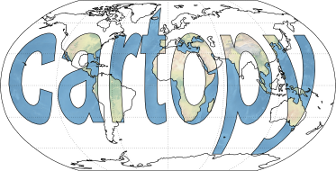Note
Go to the end to download the full example code.
UN Flag#
A demonstration of the power of Matplotlib combined with cartopy’s Azimuthal Equidistant projection to reproduce the UN flag.

from matplotlib.patches import PathPatch
import matplotlib.path
import matplotlib.pyplot as plt
import matplotlib.ticker
from matplotlib.transforms import Bbox, BboxTransform
import numpy as np
import cartopy.crs as ccrs
import cartopy.feature as cfeature
# When drawing the flag, we can either use white filled land, or be a little
# more fancy and use the Natural Earth shaded relief imagery.
filled_land = True
def olive_path():
"""
Return a Matplotlib path representing a single olive branch from the
UN Flag. The path coordinates were extracted from the SVG at
https://commons.wikimedia.org/wiki/File:Flag_of_the_United_Nations.svg.
"""
olives_verts = np.array(
[[0, 2, 6, 9, 30, 55, 79, 94, 104, 117, 134, 157, 177,
188, 199, 207, 191, 167, 149, 129, 109, 87, 53, 22, 0, 663,
245, 223, 187, 158, 154, 150, 146, 149, 154, 158, 181, 184, 197,
181, 167, 153, 142, 129, 116, 119, 123, 127, 151, 178, 203, 220,
237, 245, 663, 280, 267, 232, 209, 205, 201, 196, 196, 201, 207,
211, 224, 219, 230, 220, 212, 207, 198, 195, 176, 197, 220, 239,
259, 277, 280, 663, 295, 293, 264, 250, 247, 244, 240, 240, 243,
244, 249, 251, 250, 248, 242, 245, 233, 236, 230, 228, 224, 222,
234, 249, 262, 275, 285, 291, 295, 296, 295, 663, 294, 293, 292,
289, 294, 277, 271, 269, 268, 265, 264, 264, 264, 272, 260, 248,
245, 243, 242, 240, 243, 245, 247, 252, 256, 259, 258, 257, 258,
267, 285, 290, 294, 297, 294, 663, 285, 285, 277, 266, 265, 265,
265, 277, 266, 268, 269, 269, 269, 268, 268, 267, 267, 264, 248,
235, 232, 229, 228, 229, 232, 236, 246, 266, 269, 271, 285, 285,
663, 252, 245, 238, 230, 246, 245, 250, 252, 255, 256, 256, 253,
249, 242, 231, 214, 208, 208, 227, 244, 252, 258, 262, 262, 261,
262, 264, 265, 252, 663, 185, 197, 206, 215, 223, 233, 242, 237,
237, 230, 220, 202, 185, 663],
[8, 5, 3, 0, 22, 46, 46, 46, 35, 27, 16, 10, 18,
22, 28, 38, 27, 26, 33, 41, 52, 52, 52, 30, 8, 595,
77, 52, 61, 54, 53, 52, 53, 55, 55, 57, 65, 90, 106,
96, 81, 68, 58, 54, 51, 50, 51, 50, 44, 34, 43, 48,
61, 77, 595, 135, 104, 102, 83, 79, 76, 74, 74, 79, 84,
90, 109, 135, 156, 145, 133, 121, 100, 77, 62, 69, 67, 80,
92, 113, 135, 595, 198, 171, 156, 134, 129, 124, 120, 123, 126,
129, 138, 149, 161, 175, 188, 202, 177, 144, 116, 110, 105, 99,
108, 116, 126, 136, 147, 162, 173, 186, 198, 595, 249, 255, 261,
267, 241, 222, 200, 192, 183, 175, 175, 175, 175, 199, 221, 240,
245, 250, 256, 245, 233, 222, 207, 194, 180, 172, 162, 153, 154,
171, 184, 202, 216, 233, 249, 595, 276, 296, 312, 327, 327, 327,
327, 308, 284, 262, 240, 240, 239, 239, 242, 244, 247, 265, 277,
290, 293, 296, 300, 291, 282, 274, 253, 236, 213, 235, 252, 276,
595, 342, 349, 355, 357, 346, 326, 309, 303, 297, 291, 290, 297,
304, 310, 321, 327, 343, 321, 305, 292, 286, 278, 270, 276, 281,
287, 306, 328, 342, 595, 379, 369, 355, 343, 333, 326, 318, 328,
340, 349, 366, 373, 379, 595]]).T
olives_codes = np.array([1, 4, 4, 4, 4, 4, 4, 4, 4, 4, 4, 4, 4, 4, 4, 4,
4, 4, 4, 4, 4, 4, 4, 4, 4, 79, 1, 4, 4, 4, 4, 4,
4, 4, 4, 4, 4, 4, 4, 4, 4, 4, 4, 4, 4, 4, 4, 4,
4, 4, 4, 4, 4, 4, 79, 1, 4, 4, 4, 4, 4, 4, 2, 4,
4, 4, 4, 4, 4, 4, 4, 4, 4, 4, 4, 4, 4, 4, 4, 4,
4, 79, 1, 4, 4, 4, 4, 4, 4, 4, 4, 4, 4, 4, 4, 4,
4, 4, 4, 4, 4, 4, 4, 4, 4, 4, 4, 4, 4, 4, 4, 4,
4, 79, 1, 4, 4, 4, 4, 4, 4, 4, 4, 4, 4, 4, 4, 4,
4, 4, 4, 4, 4, 4, 4, 4, 4, 4, 4, 4, 4, 4, 2, 4,
4, 4, 4, 4, 4, 79, 1, 4, 4, 4, 4, 4, 4, 4, 4, 4,
2, 4, 4, 4, 4, 4, 4, 4, 4, 4, 4, 4, 4, 4, 4, 4,
4, 4, 4, 4, 4, 4, 79, 1, 4, 4, 4, 4, 4, 4, 4, 4,
4, 2, 4, 4, 4, 4, 4, 4, 4, 4, 4, 4, 4, 4, 4, 4,
4, 4, 4, 4, 79, 1, 4, 4, 4, 4, 4, 4, 4, 4, 4, 4,
4, 4, 79], dtype=np.uint8)
return matplotlib.path.Path(olives_verts, olives_codes)
def main():
blue = '#4b92db'
# We're drawing a flag with a 3:5 aspect ratio.
fig = plt.figure(figsize=[7.5, 4.5], facecolor=blue)
# Put a blue background on the figure.
blue_background = PathPatch(matplotlib.path.Path.unit_rectangle(),
transform=fig.transFigure, color=blue,
zorder=-1)
fig.patches.append(blue_background)
# Set up the Azimuthal Equidistant and Plate Carree projections
# for later use.
az_eq = ccrs.AzimuthalEquidistant(central_latitude=90)
pc = ccrs.PlateCarree()
# Pick a suitable location for the map (which is in an Azimuthal
# Equidistant projection).
ax = fig.add_axes([0.25, 0.24, 0.5, 0.54], projection=az_eq)
# The background patch is not needed in this example.
ax.patch.set_facecolor('none')
# The Axes frame produces the outer meridian line.
for spine in ax.spines.values():
spine.update({'edgecolor': 'white', 'linewidth': 2})
# We want the map to go down to -60 degrees latitude.
ax.set_extent([-180, 180, -60, 90], ccrs.PlateCarree())
# Importantly, we want the axes to be circular at the -60 latitude
# rather than cartopy's default behaviour of zooming in and becoming
# square.
_, patch_radius = az_eq.transform_point(0, -60, pc)
circular_path = matplotlib.path.Path.circle(0, patch_radius)
ax.set_boundary(circular_path)
if filled_land:
ax.add_feature(
cfeature.LAND, facecolor='white', edgecolor='none')
else:
ax.stock_img()
gl = ax.gridlines(crs=pc, linewidth=2, color='white', linestyle='-')
# Meridians every 45 degrees, and 4 parallels.
gl.xlocator = matplotlib.ticker.FixedLocator(np.arange(-180, 181, 45))
parallels = np.arange(-30, 70, 30)
gl.ylocator = matplotlib.ticker.FixedLocator(parallels)
# Now add the olive branches around the axes. We do this in normalised
# figure coordinates
olive_leaf = olive_path()
olives_bbox = Bbox.null()
olives_bbox.update_from_path(olive_leaf)
# The first olive branch goes from left to right.
olive1_axes_bbox = Bbox([[0.45, 0.15], [0.725, 0.75]])
olive1_trans = BboxTransform(olives_bbox, olive1_axes_bbox)
# THe second olive branch goes from right to left (mirroring the first).
olive2_axes_bbox = Bbox([[0.55, 0.15], [0.275, 0.75]])
olive2_trans = BboxTransform(olives_bbox, olive2_axes_bbox)
olive1 = PathPatch(olive_leaf, facecolor='white', edgecolor='none',
transform=olive1_trans + fig.transFigure)
olive2 = PathPatch(olive_leaf, facecolor='white', edgecolor='none',
transform=olive2_trans + fig.transFigure)
fig.patches.append(olive1)
fig.patches.append(olive2)
plt.show()
if __name__ == '__main__':
main()
Total running time of the script: (0 minutes 1.444 seconds)
